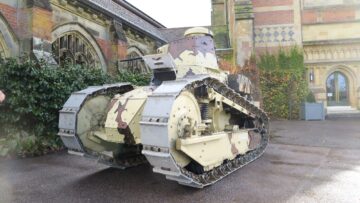Our First World War Renault FT light tank, is widely and inaccurately referred to as a Renault FT17. Due to no intact examples of the Renault FT being available we endeavoured to piece together the hull and turret.
The Renault FT hull design consists of plates and angle iron. The gathering together of the hull panels required a considerable period of time. In fact many of the panels were either missing, or in very bad shape. This was due to the original poor quality of the steel and subsequent exposure to the elements since the First World War. We were unable to secure a complete hull and were therefore in the hands of the dealer community to source the panels.
Once the panels had been secured, the plates were laid out as a giant jigsaw puzzle. This enabled us to photograph and identify each component. This process provided a lasting resource for the research effort to come. However, the hull and related components, then languished in a far corner of our sheds for many years. Finally, we began to address the issue of restoration.
To begin the work, an assessment of the hull plates was carried out. Except for the floor and framework, the plates appeared to have been remarkably well preserved. There had been some corrosion to the plates, obliterating the camouflage scheme - although a partial outline of the registration number was found on the front plate. However closer examination of the plates revealed more extensive damage.
The restoration would go on to involve many key experts, some of which would be in highly specialist fields. Additionally, the work would necessitate help from various sources such as The Tank Museum and include the search for many components. As with all our projects, research is a crucial part. This research incorporates the history, as well as ensuring that components are in keeping with the original fitting, or the paint used is an accurate representation. The real challenge in this case, was to rebuild a 100 year old vehicle.
Using many photographic and lighting techniques, together with a self-built computerized recognition program. We settled on the registration numbers 66357, after weeks of analysis by our resident scientist.
The number indicated this was a Renault produced FT, the 357th registered by the Artillery Directorate in 1918. Unfortunately, even with the help of local experts, the French archives have yet to provide supporting documentation.
All the plates had hairline or larger cracks and in places the edges had begun to delaminate, also all were extremely brittle. Samples were taken from the thinner roof and engine covers and the thicker hull plates for metallurgical analysis.
Once the analysis was complete and after many discussions with various experts, we decided to anneal the steel. A method where the metal is heated to 830 degrees Celsius and then allowed to cool slowly. This realigns the steel at a molecular level removing the brittleness. We still had to repair the cracks, so many a late night was spent on this process.
Our vehicle had been stripped of all suspension parts prior to being embedded in concrete. Where could we find the necessary road wheels, suspension boom, idler wheels, drive wheels and track links. It is difficult enough finding German parts from the Second World War let alone finding usable 100 year old parts. The Tank Museum came to mind as they have the only Renault FT in the UK. They very kindly allowed us to carefully remove a number of left hand side suspension items including the large wooden idler wheel.
At this point we decided to revisit the camouflage issue. We were collecting the plates for a TSF (Telegraphie Sans Fil ) or Wireless tank and some plates had traces of paint left on them. We decided to talk to the Crick Smith Institute at the University of Lincoln, regarded as one of the worlds leading consultancies, specialising in historic paint research. They analysed the paint on some of the smaller TSF body plates
The quest for engines, gearboxes and internal components continued. Here we were fortunate in tracking down a Renault GP tractor, complete with spare engine owned by a French collector. The tractor was assembled on the same lines as the FT. The internal components of the GP are identical to those of the FT. The same gearbox, the same engine and the same final drives in their casings.
As with our other restorations many other components have to cast or machined, such as the Tank track links and carburettors based on detailed drawings from other sources. For instance the only complete original radiator was sourced in Brent Mullins’s FT in Texas. Fort Seclin had a destroyed engine which we borrowed. We made patterns of the clutch, flywheel other smaller items such as the gear gate and foot pedals. For every part we borrowed we provided a copy. Some required more than one copy in exchange.
- This article has 818 words
- Reading time: 4 minutes
- There are no photos
Become a Member - Access the Full Article
Members gain access to the full content of our articles, including photo galleries.

